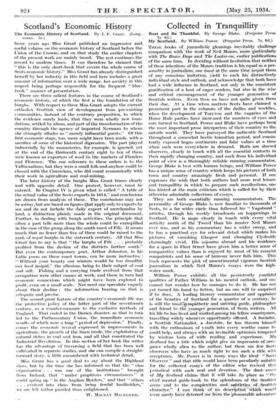Scotland's Economic History
The Economic History of Scotland. By L F: Grant. (Long-. • mans. 58.)
SOME years ago Miss Grant published an impressive and useful volume on the economic history of Scotland before the. Vnion of the Crowns, and on that 'study the earlier chapters Of the present work are mainly based: • The rest continues the: record to modern times. It can therefore be claimed that. "this is the only short-book that coVerg the-whole course of Soots economic history.". Miss Grant has already distinguished; herself by her industry in this field and here includes a great amount of information over a wide range, her anxiety in this_ respect being perhaps responsible for the frequent " blue book " manner of presentation.
There are three salient features in the course of Scotland's. economic history, of which the first is the foundation of the burghs. With respect to these Miss Grant adopts the current orthodox Scottish view of development from pre-existing communities, instead of the contrary proposition, to which the evidence surely leads, that they were wholly new foun- dations, settled by aliens, and part of the transformation of the country through the agency of imported Normans to whom she strangely alludes as " merely influential guests." Of this
economic stage, too, more might have been made, with a sacrifice of some of the historical digression. The part played industrially by the monasteries, for example, is ignored, yet at the end of the thirteenth century eight to ten of them were known as exporters of wool to the markets of Flanders and Florence. The one reference to these orders is to the Valliscaulians, but they were a small folk and anyhow could be classed with the Cistercians, who did count economically with their work in agriculture and coal-mining.
- The later history of the burghs Miss Grant traces clearly and with apposite detail. One, protest, however, must be entered. In Chapter IV is given what is called " A table of the actual value of the Scots exports In 1614," and conclusions are drawn from analysis of these. The conclusions may not be astray, but are based on figures Oat apply only to exports by Sea and do not include the daily export of merchandise by land, a distinction plainly made in the original document. Further, in dealing with burgh activities, the principle that often a part tells more than the whole could be exemplified in the case of the group along the south coast of Fife. It means much that no fewer than five of these could be raised to the ..rank of royal burghs in the sixteenth century. All that Miss Grant has to say is that " the burghs of Fife . . . probably profited from the decline of the districts farther south." But even the contemporary poet, Arthur Johnston, in his Latin poem on these coast towns, can be more instructive :
Without your bounty our winters. would-be too dreadful, our food insipid," the allusions being to _their output of coal and salt. Fishing and a carrying trade evolved from that pecupation were other causes at work, and these in turn had economic connexions which might have been explored to profit, even on a small scale. Nor need one speculate vaguely ;about their decline : the information bearing on that is adequate and precise.
The second great feature of the country's economic life was Abe protective. policy of the latter part of the seventeenth -century, us a counter-measure to the exclusiVe methods of England. That ended in the Darien disaster, as that in turn ' led to the Parliamentary -Union, the immediate economic .results of which were a long ". period. of depression." Finally, ,comes the economic revival expressed in improvements in '-agriculture, the growth of the linen trade, the exploitation of ';natural riches in coal and iron, and all that constituted the 'Industrial Revolution. In this section of her book the writer has the advantage of traversing a field that has been well cultivated in separate studies, and she can compile a straight-
forward story, a little encumbered with technical detail. • Miss Grant tins a good deal to say about the Highland chins. but by the time she has informed us that the " clan '-organization-. . was one • of the institutions" brought from Ireland, that " under 'propitious- circumstances" it could spring up " in the Anglian Borders," and that others - evolved into clans 'from behig • feudal landholders," we are left rather puzzled than enlightened.
W. MACKAY 111..tc=sizim.
















































 Previous page
Previous page